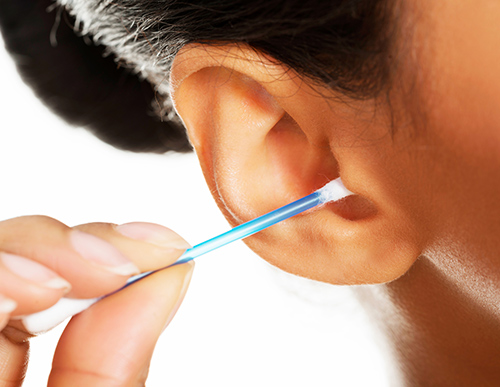
You are hereby given permission to stop cleaning your ears out with swabs every day. In fact, we beg you, for your hearing’s sake, to stop it immediately! The warning on your box of swabs, your hearing care professional, the American Academy of Otolaryngology-Head and Neck Surgery (AAO-HNS)
and your grandma all agree that you should never put anything into your ear that’s any smaller than your elbow. Here are 5 reasons why this is true:
1. Ear Wax is for Cleaning
Ear wax is actually called “cerumen” by scientists and doctors, and it’s not actually even wax in the traditional sense. It’s an ear-cleaning solution that’s made specifically by your ears to keep your ears clean. So just let it do its job, for crying out loud. It traps stray dust and dirt, preventing it from getting deeper into your ear canal. Then, as you go through your day talking, chewing and yawning, those actions actually move the soiled ear wax down and out of the ear canal where you can easily wipe it out with a washcloth during your shower.
Furthermore, if you try to dig out the ear wax with a fingernail, swab, fork, pencil, key, chopstick or other pointy foreign object, you’re actually reversing your ears’ self-cleaning mechanisms by pushing soiled cerumen further into your ear canal with all the dust and dirt it’s collected. If you keep doing this, that old ear wax can get clogged against your ear drum. So stop it.
2. Ear Wax is a Health Potion for Your Ears
While nobody would ever want to encounter an ear wax flavored Bertie Bott’s Every Flavor jellybean, cerumen actually has many special properties that help keep your ears healthy, so you really should let it work for you. Several glands lining the inside of your ear canal produce a special recipe of cerumen just for your own ears. This recipe contains a mixture of long-chain fatty acids, alcohols, enzymes, cholesterol, sebum, sloughed off skin cells and other chemicals that perform a wide range of ear-protecting functions like:
- It’s antimicrobial; it protects your ears against viral, fungal and bacterial infections very effectively.
- It repels insects—their sensitive sense of smell finds ear wax too stinky.
- It lubricates and moisturizes the ear canal, keeping it healthy and soft.
- Healthy ear wax is slightly acidic, something else that hinders fungal and bacterial growth in your ears.
Thanks again, ear wax!
3. Ear Wax Removal is Bad for Your Hearing
You may already have sustained some level of hearing loss, just from the process of swab-based ear wax removal habits. This type of ear wax removal actually shoves soiled, old ear wax further down into the ear canal where it can become impacted and cause hearing loss. If you’ve been doing this for years, schedule an appointment with your hearing care professional to have them check whether you have impacted ear wax that might be causing some amount of hearing loss.
Now, you may be one of those people who actually do have a problem with ear wax (beyond just wanting it gone). Some people make too much, while others don’t make enough. Occasionally, it may be too wet, too dry or not have the right balance of ingredients to get the job done right. Nevertheless, you still shouldn’t try to remedy or clean it out yourself with a swab or anything else (smaller than your elbow). If you’re worried about the health of your ear wax, please get in touch with your hearing care professional for an evaluation.
Wearing hearing aids can also be a bit problematic for ear wax, but if you follow your hearing care professional’s instructions on proper hearing aid cleaning and gently washing out your ears (no swabs or pointy things), you should be able to prevent excess ear wax from blunting the operation of your hearing aids, or from having ear wax impaction problems.
4. You Can Prevent Ear Cleaning Accidents
But sadly, they happen all too often. About 12,500 kids all across America end up in the doctor’s office each year with ear cleaning injuries like torn tympanic membrane (ear drum) or cuts and lacerations inside the ear canal. Unfortunately, these accidents can cause hearing loss, particularly during a developmentally important time in life. Aggressive ear cleaning with pointy objects is something the whole family could do without.
And don’t get us started on “ear candling”. Thousands of people sustain “ear candling” injuries every year, which is very unfortunate. Often advertised at your local health food store as a “natural ear wax removal” technique, ear candling enthusiasts stick a hollow, cone-shaped candle into their ear canals and set it on fire. Who thought that was a good idea? Just because it’s billed as “ancient” and “natural” doesn’t mean it’s actually good. Here’s what you need to know about ear candles:
- It’s been proven ineffective for ear cleaning and can actually make ear wax impaction worse.
- It causes burn injuries to the face, ears, hair, etc. – even burns that go all the way to the ear drum and middle ear.
- It’s also been known to puncture the ear drum.
So please—avoid ear candling and just clean your ears the proper way…
5. There is a Safe Way to Clean Your Ears, and it’s This:
It’s so simple, you probably already do it: just gently wash around the outside of your ears with a washcloth while you’re showering. Then gently towel off the water and that’s about it. No follow-up with a swab needed, and definitely not recommended.
If you have any concerns about your ear wax, your hearing, ear wax removal, ear cleaning habits or anything else associated with your ears, schedule an appointment with your hearing care professional today—and be grateful for your wonderful ear wax!
